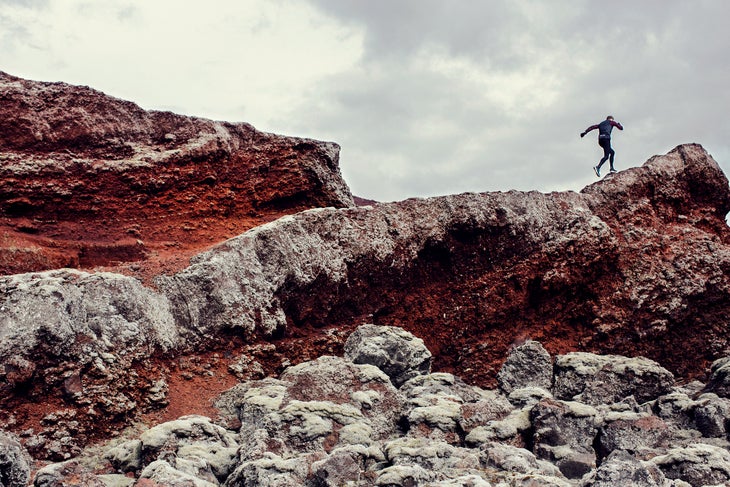New perk! Get after it with local recommendations just for you. Discover nearby events, routes out your door, and hidden gems when you sign up for the Local Running Drop.
Strength work is like flossing. We know we should do it, but…let’s be real. Most of us floss or do strength for a few weeks before letting it fall by the wayside.
If you have a good strength routine that you do without fail, stop reading now. Detailed routines designed by physical therapists or strength coaches are the best options.
The coolest thing about this simple routine is that you can do it for years without worrying much about changing approaches.
But what I see in coaching is that lots of athletes are like me, with a switch that flips from “RAWR I WORK HARD” to “Exceedingly lazy unless we’re talking about potato-chip testing” as soon as the daily run ends.
So over the last few years, my co-coach Megan (a doctor and the brains of the operation) and I designed a quick routine that we found athletes can do almost anytime. It started at five minutes, but was shortened even more when we saw some athletes not completing it consistently, plus we decided that a couple of the exercises were physiologically redundant.
What we are left with is the 3-Minute Mountain Legs routine. Pros like Jason Schlarb use this quick routine to build strength for climbing and descending, along with most of the other athletes we coach, including road racers. We recommend athletes do it three to four times per week after runs, aiming to concentrate the stimulus on days when they are doing harder training. There are just two exercises.
Single-Leg Rear Lunge (20 to 50 on each leg)
The single-leg rear lunge targets the glutes and quads, two of the main power-centers for running. We have found rear lunges are more protective of the patellar tendon, avoiding runner’s knee and more serious conditions.
Rear lunges also involve eccentric contractions, with the muscle engaged with a straight leg, then lengthening under load. That’s similar to running steep downhills, and some of our athletes attest to far less post-activity soreness when they do rear lunges consistently.
Warning: you may get exceedingly sore from these at first, especially in the glutes and upper hamstrings. Start with just 5 to 10, increasing up to 50 for advanced athletes over time. Personally, I settle in at 20 to 30.

Single-Leg Step-Ups (30 to 100 on each leg)
To understand why single-leg step-ups work, it might be most helpful just to do a set, preferably after having run up a steep hill. After 20, you’ll probably notice a feeling that is very similar to what you just felt on the hill. They engage the quadriceps muscles with similar biomechanical patterns as uphill running, and doing one leg at a time doesn’t let the muscles relax between work bouts, giving it a boost that some athletes attest helps them climb stronger.
Unlike rear lunges, step-ups are mostly concentric motion, much like uphill running (though there may be a minor eccentric stress during the downward movement). Some athletes on the team have excelled on doing up to 100, but I personally cannot do 100 consistently without having my heart fill with dread and sadness for the pain that awaits. For me, 50 is ideal, and that’s generally what we recommend to athletes.
Do them up two steps, or other surface of similar height, to maximize power demand without reducing the angle formed by your shin, knee and femur below 90 degrees, which could increase knee-injury risk.
For both exercises, just use your arm to stabilize, not letting it support weight, and aiming not to use it at all to work on balance and stabilization. Avoid bouncing in the motion, trying to stay controlled, while still moving somewhat rapidly through each repetition. And remember: the goal isn’t to get good at doing strength work, it’s to get better at running. The coolest thing about this simple routine is that you can do it for years without worrying much about changing approaches.
Combine this routine with mobility work (like Coach Jay Johnson’s myrtl routine) and stretching/massage that works for you, and you can transform yourself into an injury-proof super runner. You may even find the resolve to start flossing.
I promise, 3-Minute Mountain Legs will never be easy to finish. But its simplicity will make it easy to start, and that’s the most important thing.
David Roche partners with runners of all abilities through his coaching service, Some Work, All Play. With Megan Roche, M.D., he hosts the Some Work, All Play podcast on running (and other things), and they wrote a book called The Happy Runner.